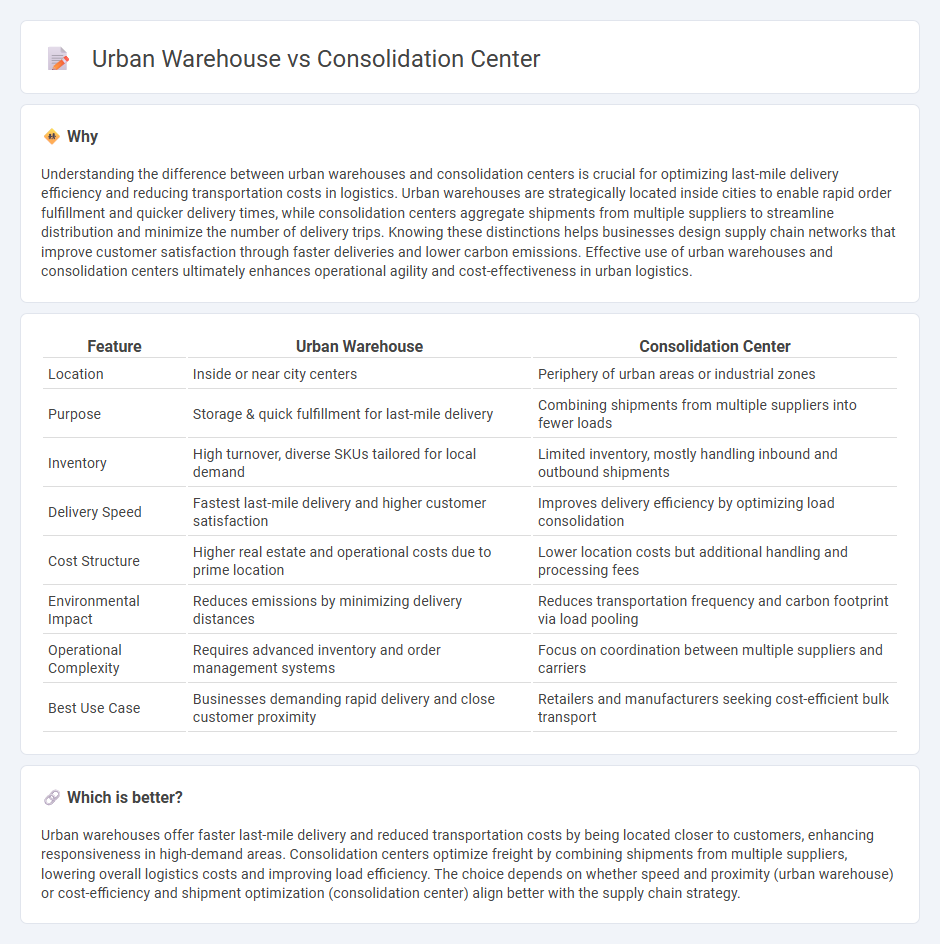
Urban warehouses strategically position inventory closer to high-demand areas, enabling rapid order fulfillment and reducing last-mile delivery costs. Consolidation centers aggregate shipments from multiple suppliers, optimizing load capacity and cutting transportation expenses through efficient route planning. Explore the differences between urban warehouses and consolidation centers to enhance your logistics strategy.
Why it is important
Understanding the difference between urban warehouses and consolidation centers is crucial for optimizing last-mile delivery efficiency and reducing transportation costs in logistics. Urban warehouses are strategically located inside cities to enable rapid order fulfillment and quicker delivery times, while consolidation centers aggregate shipments from multiple suppliers to streamline distribution and minimize the number of delivery trips. Knowing these distinctions helps businesses design supply chain networks that improve customer satisfaction through faster deliveries and lower carbon emissions. Effective use of urban warehouses and consolidation centers ultimately enhances operational agility and cost-effectiveness in urban logistics.
Comparison Table
| Feature | Urban Warehouse | Consolidation Center |
|---|---|---|
| Location | Inside or near city centers | Periphery of urban areas or industrial zones |
| Purpose | Storage & quick fulfillment for last-mile delivery | Combining shipments from multiple suppliers into fewer loads |
| Inventory | High turnover, diverse SKUs tailored for local demand | Limited inventory, mostly handling inbound and outbound shipments |
| Delivery Speed | Fastest last-mile delivery and higher customer satisfaction | Improves delivery efficiency by optimizing load consolidation |
| Cost Structure | Higher real estate and operational costs due to prime location | Lower location costs but additional handling and processing fees |
| Environmental Impact | Reduces emissions by minimizing delivery distances | Reduces transportation frequency and carbon footprint via load pooling |
| Operational Complexity | Requires advanced inventory and order management systems | Focus on coordination between multiple suppliers and carriers |
| Best Use Case | Businesses demanding rapid delivery and close customer proximity | Retailers and manufacturers seeking cost-efficient bulk transport |
Which is better?
Urban warehouses offer faster last-mile delivery and reduced transportation costs by being located closer to customers, enhancing responsiveness in high-demand areas. Consolidation centers optimize freight by combining shipments from multiple suppliers, lowering overall logistics costs and improving load efficiency. The choice depends on whether speed and proximity (urban warehouse) or cost-efficiency and shipment optimization (consolidation center) align better with the supply chain strategy.
Connection
Urban warehouses and consolidation centers play a crucial role in optimizing last-mile logistics by reducing delivery times and minimizing transportation costs. Consolidation centers collect goods from multiple suppliers and organize shipments to urban warehouses closer to the final delivery points, enhancing inventory management and improving distribution efficiency. This interconnected system supports sustainable urban logistics by decreasing traffic congestion and lowering carbon emissions associated with freight transport.
Key Terms
**Consolidation Center:**
Consolidation centers aggregate shipments from multiple suppliers to optimize transportation and reduce costs by minimizing the number of trips to urban warehouses or retail locations. These centers streamline logistics operations by combining smaller loads into full truckloads, enhancing delivery efficiency and reducing environmental impact. Explore how consolidation centers can transform your supply chain management by driving cost savings and operational efficiency.
Cross-docking
Consolidation centers streamline shipments by grouping smaller packages into larger loads, optimizing cross-docking processes for efficient last-mile delivery in urban areas. Urban warehouses prioritize speed and proximity to consumers, enabling rapid sorting and immediate dispatch through cross-docking to meet same-day or next-day delivery demands. Explore the differences in operational strategies and benefits between consolidation centers and urban warehouses for cross-docking efficiency.
Load optimization
Load optimization in consolidation centers maximizes shipment efficiency by aggregating multiple suppliers' goods, reducing transportation costs and improving delivery timelines through full truckloads. Urban warehouses prioritize rapid order fulfillment in dense areas, focusing on smaller, more frequent loads to meet consumer demand quickly. Explore the strategic differences in load optimization between consolidation centers and urban warehouses to enhance your supply chain management.
Source and External Links
Consolidation Center Definition and Meaning - Buske Logistics - A consolidation center is a logistics facility where small shipments from different suppliers are combined into larger loads to reduce transportation costs, improve delivery efficiency, and streamline the supply chain for retailers and distributors.
How Walmart's Consolidation Centre Improves the Supply Chain - Walmart's high-tech consolidation centers receive smaller freight loads from suppliers, consolidate them into full truckloads, and ship to regional distribution centers, enhancing supply chain efficiency and reducing costs for both Walmart and suppliers.
Consolidation Warehousing: Guide, Tips, + Benefits (2025) - ShipBob - A consolidation warehouse gathers and sorts multiple small shipments by destination to send as larger combined shipments, suited for businesses with many suppliers or concentrated customers aiming to lower shipping costs and carbon emissions.
 dowidth.com
dowidth.com